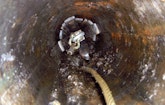Interested in Inspection?
Get Inspection articles, news and videos right in your inbox! Sign up now.
Inspection + Get AlertsFire flows as low as 300 to 400 gpm and customer complaints of rusty water kept the Marion (Ind.) Water Department busy flushing the 4-inch cast-iron pipes. The process dropped the residual pressure so low that residents called to ask why their water was shut off — and the rust always returned.
For years, the city upgraded the mains in the downtown area by boring and installing 6- and 12-inch pipes, then connecting hydrants to them. One remaining original section was a 1,200-foot-long elbow with both ends connected to new pipe. The line paralleled a state highway for a block, then turned and ran for three blocks, feeding two apartment buildings, a church, community center and four homes. City engineers estimated the cost to trench and replace it with 6-inch pipe at $350,000.
“During previous upgrades, we spot-repaired some leaks and installed Inserta valves where needed,” says David McCollum, project specialist. “The tuberculation we saw in the removed sections reduced flows by 50 percent.”
In 2010, the city hired Gary Sorohan, founder of Triton Lining Technologies, to clean and coat 2,500 feet of corroded pipe in two residential neighborhoods for $46,000. The spincast epoxy coating restored the host pipe’s pressure and flow. Sorohan then rehabilitated the problematic elbow for $21,600, completing the project in four days.
Preparations
Department workers excavated access points at fittings 400 to 500 feet apart, then poured a gravel bed into the downstream hole. They built a wet well from a 55-gallon drum, drilled holes near the bottom, then installed a pump. During pipe cleaning, the drum kept debris from entering the pump as it discharged water to the sewer. The crews later buried the material when they backfilled the excavations.
The department set up a temporary non-potable waterline to customers and supplied them with cases of bottled water for drinking. “It was easier and faster that way,” says McCollum. “We told them not to cook with or drink the water coming out of their taps.”
Sorohan and the crew used pairs of clamped Christmas tree drag scrapers custom made in Great Britain to clean the encrustation and tuberculation.
“We don’t hydroblast because that would also remove the graphitization,” he says. “When the pipe is attacked from the inside, the stable graphite remains in place, but the metallic material has no structural integrity. We leave the graphitization for a smoother contour when spraying the coating.”
The 75- to 100-year-old calcium tuberculation was the hardest Sorohan had ever cleaned. The crew initially took off some scraper arms to avoid removing too much material and plugging the hole. A winch pulled the tool through 12 or more times to clean some sections. Crews worked until dark, and the process took two-and-a-half days.
Blow dry and spincast
To remove tailings from the pipe, Sorohan’s team dragged through squeegee plugs. Then they flushed the line using sponge pigs and water and dried it with additional sponge pigs. Because any moisture in the line would compromise the coating, department workers looked for weeping valves or service connections with their RIDGID SeeSnake push camera and CUES camera van. “We always found some leaks,” says McCollum. “We’d close those valves or shut off the services, and Gary would dry the line again.”
Once the pipe was cleared for lining, workers inserted an umbilical hose from the Triton lining rig into the pipe and pulled it to the exit pit. The umbilical carried hoses for the epoxy resin, activator, air and water. The airline powered the motor driving the rotating spray head.
Besides numerous sensors and monitors, the rig had a water jacket surrounding the resin and activator tanks, and a propane heater for the water that heated the components to 113 to 122 degrees F. Three hoses recirculated the water from the heater to the spray head to maintain an even resin temperature during the lining process.
In the exit pit, workers attached a static mixer to the spray head and actuated the pumps and air. “We expel the resin into a bucket until the mix ratio stabilizes,” says Sorohan. “Then we engage the winch powering the hose drum and draw the spray head backward, coating the pipe in reverse.”
A computer controlled the temperature of the epoxy and activator, pressures on each line, water temperatures, flow rates, mixing ratios, withdrawal speed and coating thickness (1.2 mm).
Winding down
The coating dried to the touch in three hours and cured overnight. The next morning, McCollum’s crew inspected it for imperfections. Finding none, they flushed the line with water, then sanitized it with a 12 percent liquid chlorine solution. The charged pipe sat overnight, and then workers flushed it again and tested the water before returning it to service.
The seamless protective barrier eliminated corrosion and tuberculation, prevented their recurrence, restored water quality, ended customer complaints, and improved the C-factor (hydraulic efficiency) to optimal levels. “Our fire flows went from 300 to 400 gpm to 900 to 1,000 gpm,” says McCollum. “This summer, we’re doing a flushing program to help identify next year’s coating projects.”









